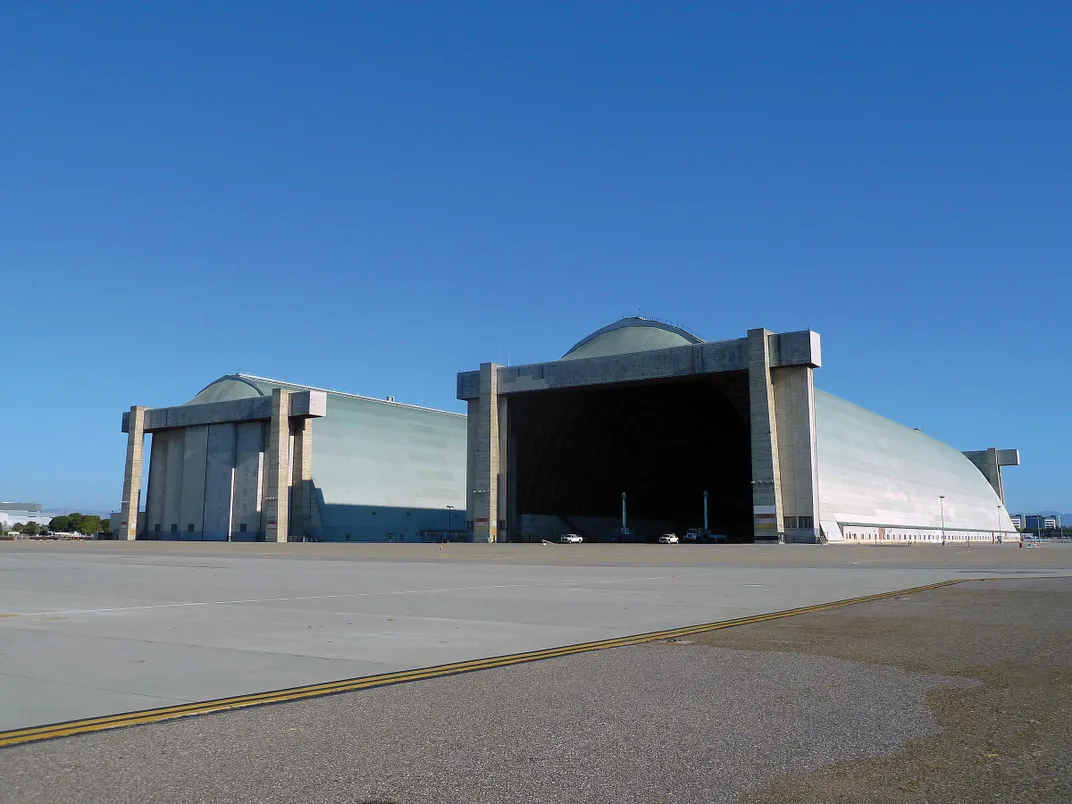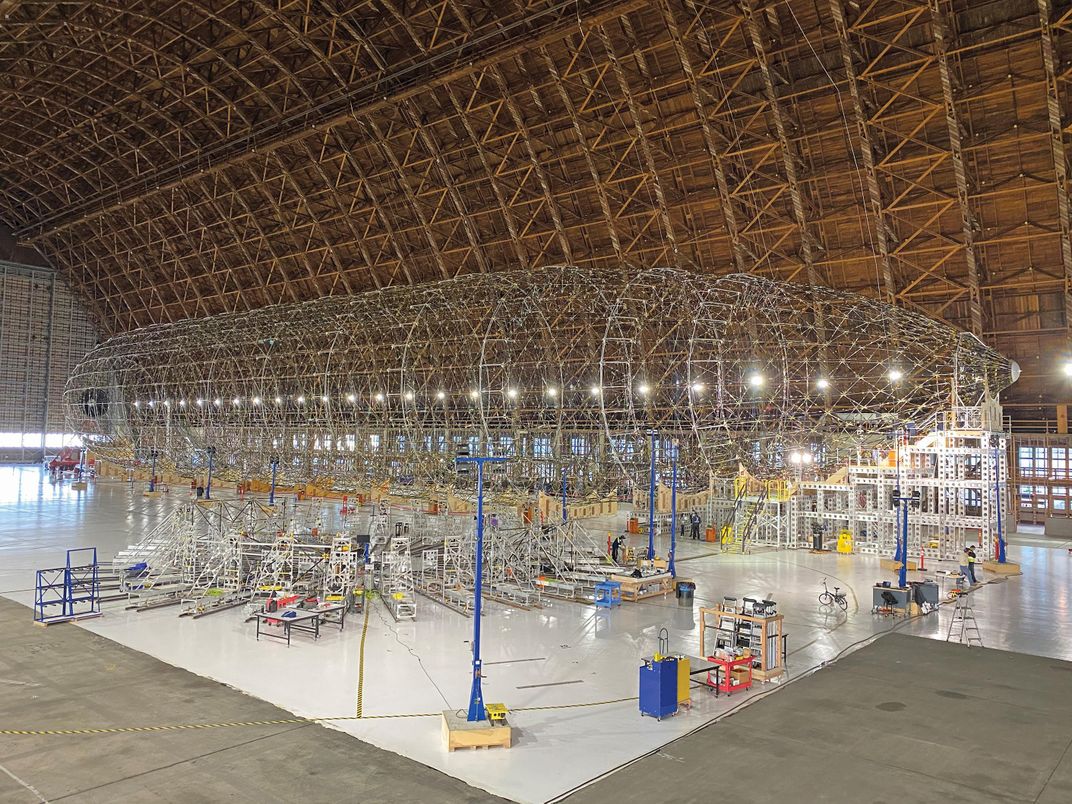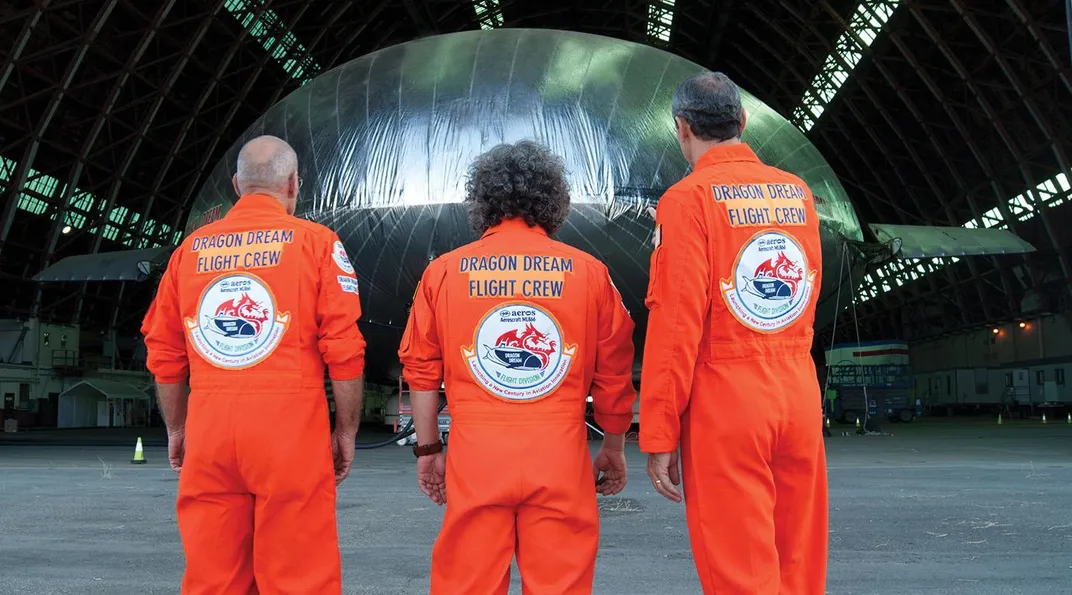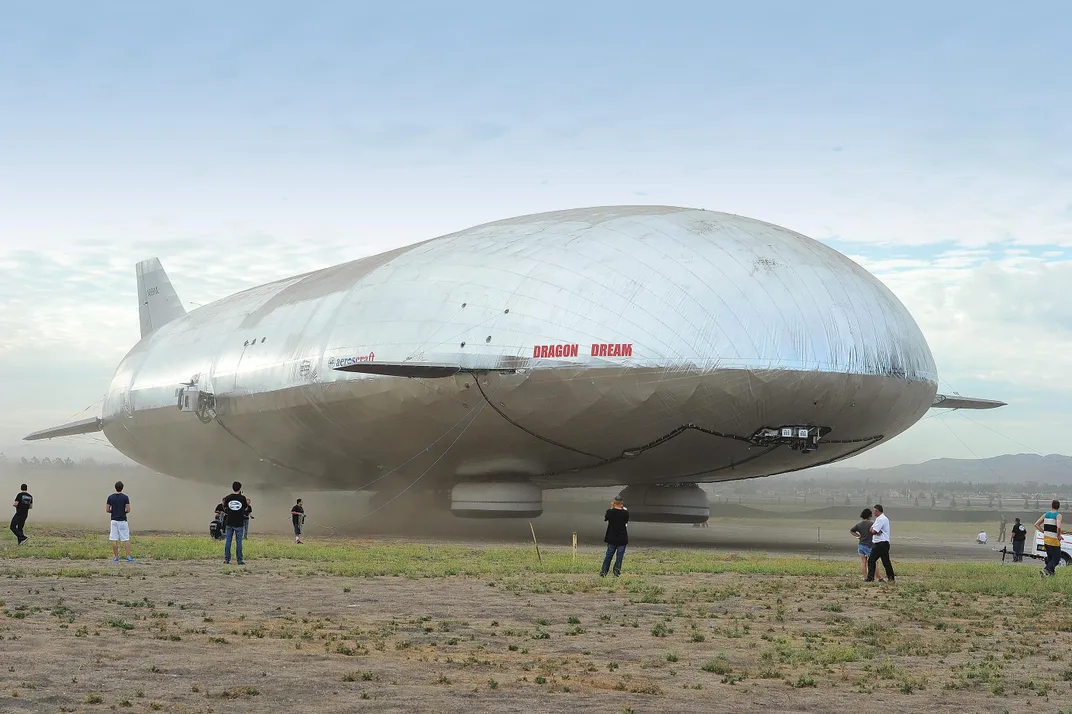Airships Rise Again
Zero emissions and a million pounds of lift renew the appeal of these century-old giants.
:focal(2132x2586:2133x2587)/https://tf-cmsv2-smithsonianmag-media.s3.amazonaws.com/filer/d4/f7/d4f7cc05-fef1-4202-b60d-11fd48551ed7/opener.jpeg)
Tom Grundy, the CEO of Hybrid Air Vehicles, started his career working on fighters and drones for BAE Systems, and he was a project engineering manager for Airbus during the development of the A380. But these days his focus is on a type of aircraft that can do things the fixed-wing fliers he has spent his life admiring can’t—even though the basic technology keeping them aloft is substantially older. Welcome to the second age of the airship.
Grundy’s company is promoting its striking, pillow-like AirLander 10, initially designed for military surveillance, as a pleasant, low-emission alternative means of regional air travel. In May the company announced plans to begin service for up to 100 passengers per flight on a handful of short-haul routes (Liverpool to Belfast, Oslo to Stockholm, Seattle to Vancouver, among others) in 2025. A Scandinavian company is in talks about using the AirLander to give tours of the North Pole.
The chief market for the airships of the 21st century, however, will not be passenger service but freight hauling. The new airships can carry heavier loads farther and cheaper than helicopters can, with lower emissions than fixed-wing aircraft—potentially zero emissions, if the ships are powered by hydrogen fuel cells.

Historically, there have been two major types of airship. Rigid airships, as the name implies, are built around a hard skeleton. Count Ferdinand von Zeppelin of Germany flew the first rigid airships, and on his account, they are sometimes called Zeppelins. The other type of airship is non-rigid. Non-rigid airships have no skeleton. They consist of an envelope inflated with a lifting gas such as helium, from which is suspended a gondola for crew, passengers, and cargo. The familiar Goodyear blimps have been mostly non-rigid airships.
The engineers at Hybrid Air Vehicles looked at the history of rigid and non-rigid airships and came down solidly on the non-rigid side—with a twist. Rather than the cigar or American football shapes of past airships and blimps, the AirLander looks more like a pillow. A radically different design, it’s a lifting body—and heavier than air. It relies on both aerostatic lift from helium and aerodynamic lift to fly, making it a hybrid airship. “About 40 percent of our lift is aerodynamic,” Grundy says. “When we turn our engines off and we slow down, we’re heavier than air. We come down and land just like airplanes do.”
The appealing energy efficiency of airships comes from their ability to float in the air as boats do on water—so it seems strange to purposefully erode that lighter-than-air quality. But there is another, problematic side to aerostatic buoyancy. “If you are taking 50 tons of cargo to a remote part of the world,” Grundy says, “and you want to put that 50 tons down in [that same spot], you now have 50 tons of buoyancy you have to deal with.” Like a pool float held underwater, it’s going to surge upward once you let off the pressure. Airships of yore would manage by venting lifting gas (not something you want to do with limited and expensive helium), taking on ballast, and elaborate rope and mooring procedures. That’s a nonstarter if you want to make money taking big things to places with little infrastructure, Grundy says, but he believes the AirLander is the answer.
When the AirLander had its first flight in Lakehurst, New Jersey in 2012, it was intended as a U.S. Army surveillance craft. The Army canceled that program the following year, and HAV brought the ship across the Atlantic to Cardington, about 60 miles north of London, for a 2016 series of flights that would test its viability for civilian use. In November 2017, the unoccupied AirLander broke free from its mooring mast and deflated. Grundy says the lessons of this incident resulted in improvements to the production model, which remains on schedule. “Our base business plan sees us delivering 12 aircraft per year” beginning as soon as 2025, he says.

Gentle Giant
The Graf Zeppelin was 776 feet long. Even non-rigid airships could be enormous, according to Wichita State University professor of aerospace engineering Brandon Buerge. He cites the U.S. Navy’s N-Class blimps of the 1950s, tasked with anti-submarine and early-warning missions. They could be as large as 400 feet long and 120 feet tall, “bigger than anything we’ve been flying with any regularity,” Buerge says.
Early on, the German Zeppelins racked up an impressive record for safety and capability. The Graf Zeppelin flew more than a million miles beginning in 1928, circumnavigated the globe, and lifted more than 43 tons. “How long did it take before fixed-wing aircraft caught up?” Buerge asks. (About 30 years. The C-133 Cargomaster—first heavy lifter in the U.S. Air Force—entered service in 1958 and could carry more than 55 tons, but it had four jet fuel-guzzling turboprops.)
Still the rigid giants eventually proved fragile. The German airships used flammable hydrogen for lift, which led to the Hindenburg disaster. And the U.S. Navy’s rigid airships displayed an alarming tendency to break up in bad weather. The Germans scrapped the Graf Zeppelin at the start of World War II, while the American Navy stuck with non-rigid blimps, using them to escort shipping convoys. The blimps proved much more resilient, with one N-Class blimp, the Snowbird, crossing the Atlantic twice and beating the Graf Zeppelin’s record for endurance by flying for more than 264 hours through all kinds of weather.
“Those are the ships they would plow through ice storms,” Buerge says. “It’s hard to kill a non-rigid airship.”

No Mirage
As you approach Moffett Federal Air Field in Sunnyvale, California, Hangars Two and Three are easily visible from U.S. 101, their parabolic apexes and massive door frames hulking over the relatively flat desert landscape. Seeing them from a distance does not prepare you for the feeling of their immensity as you stand between them. The giant hangars channel the early summer breeze like a box canyon. In the 1930s, they housed U.S. Navy airships like the Macon, a behemoth 785 feet long and 150 feet high. More recent tenants include the California Air National Guard and NASA.
The current occupant of Hangar Two, LTA Research, is using it to house airships again. My tour guides on this bright June morning are LTA CEO Alan Weston and LTA chief of operations James McCormick, who acts as a sort of ground wire for Weston’s seemingly boundless energy. Inside the hangar, a chorus of birdsong echoes down from the rafters far overhead.
Before us stands the naked, cigar-shaped skeleton of the airship they have dubbed Pathfinder 1, a 400-foot-long vessel that could easily swallow the fuselage of the Boeing 737 that brought me to California. It’s more organic sculpture than airframe, a latticework of black carbon-fiber tubes rising like the bones of an ancient leviathan awaiting its taxidermied skin—in this case, high-tech sailcloth.
“Isn’t that cool?” Weston asks.
His excitement is catching, but he is in some ways a strange ambassador for the return of a technology that for most of the last 70 years has been more prevalent in science fiction than in the real world, those floating billboards hovering over football stadiums notwithstanding. “Most of my career has been in spacecraft and rockets,” Weston says. He designed kill vehicles for President Ronald Reagan’s Star Wars program and spent 23 years doing research and development for the U.S. Air Force. Then he served as director of programs at NASA Ames Research Center until his retirement in August 2013.
Retirement did not last long. Late that same year, Google co-founder Sergey Brin asked Weston to create a company to build an airship that could carry cargo on his humanitarian relief missions.
Weston’s enthusiasm for his new project grew as he studied the history of airships. The Hindenburg disaster of 1937 might have been the death of airships in the popular imagination, but there have been fresh design efforts in every decade since. (John McPhee’s book The Deltoid Pumpkin Seed documents a push by a strange coalition of former Navy airship men and Presbyterian ministers to develop a hybrid airplane/rigid airship in the 1970s. Their ship flew, but no one wanted it. Their dreams of at once revolutionizing air freight and missionary work went unfulfilled.)
His history lessons complete, Weston concluded that the challenges that plagued the older rigid airships could be overcome. They would use non-flammable helium as a lifting gas, for starters. And the flaws that brought down Navy airships like Akron and Macon—a faulty altimeter and structural damage, respectively—could be corrected with modern avionics and strong, light materials. Each of the 13 rib-like carbon fiber “mainframes” that make up the length of Pathfinder 1 weighs just 600 pounds, but together, they support a vessel with 28 tons of lift. A broken carbon tube can be replaced in-flight.
“The beautiful thing about a rigid airship is you can almost do anything you want,” Weston says. “The problem with all these blimps is you don’t have any hard points.”
Pathfinder 1 will support a gondola, diesel generators, solar panels, batteries, electric motors, and vectored thrust propellers, as well as a small gangway running the length of the envelope for accessing the interior frame. While LTA will not disclose the dimensions of its in-development Pathfinder 3, it will be substantially more capacious than Pathfinder 1, with room enough in the crew gangway for passengers and for hydrogen—for fuel cells, rather than for lift.
Beyond Pathfinder 3, LTA aims to build a massive rigid airship that will dwarf the Zeppelins of the past. All LTA will say on the record about its next-gen giant is that it will be too big to be built in Sunnyvale—LTA is in the process of moving into the former Goodyear Airdock hangar in Akron, Ohio. “The AirDock goes on top of this,” Weston says, gesturing up toward Hangar Two’s distant ceiling. “This is 160 feet tall. The AirDock is 200 feet tall.”
That ship isn’t scheduled to fly until 2023 at the earliest, and Weston and his team have plenty to keep them busy in the meantime, like fully outfitting Pathfinder 1 and flying it to its new home in Akron—following a series of flight tests around the San Francisco Bay area.
Though Weston hopes to begin these short-distance “camping trips” this year, they are currently unscheduled. “History is full of airship projects that crashed or something bad happened because people were in a rush,” Weston says. “We’re going to be careful.”

Igor Pasternak shares Tom Grundy’s view that buoyancy control is key to building a commercially practical airship. The founder of Worldwide Aeros Corporation in Montebello, California, Pasternak built tethered balloons called aerostats as a teenager growing up in Ukraine. Airships, he says, are “what I have been doing all my life.”
He thinks, though, that relying on aerodynamic lift and vectored thrust will limit an airship’s operational capacity. Requiring a runway, even a short one, is another limitation. The vehicle under construction at Worldwide Aeros, the Aeroscraft Dragon Dream, is a non-cylindrical rigid airship. It takes a different approach than Hybrid’s AirLander, using a low-pressure system to compress and release helium to modulate the lift of the airship—compress the helium, shrink its volume, and you reduce aerostatic lift. Prove a heavy-lifting airship can perform true vertical take-offs and landings without ground infrastructure, Pasternak says, and “we are talking about a huge shift, dramatic shift” in the transport business.
That proof is yet to come. The design review for the Dragon Dream operational demonstrator was completed only last summer, and he won’t say when its next test flight will be. As with LTA, he’s pushing the humanitarian applications of airships, having entered into a partnership with the World Food Program that he hopes will eventually see his invention delivering food to famine-struck regions.

The emphasis on charity might help to cover up some observers’ skepticism. “Hope springs eternal” is what aviation analyst Richard Aboulafia says when I ask him if the new airship ventures will change the market. “Frankly, it doesn’t scale,” he explains. “Air travel is all about scale, getting 300 people into a 777. You just can’t do that with these things.”
He can’t readily think of a cargo someone would need to send faster—and at a higher price—than by ship, but slower than by jet. And exotic cargo flown to remote locales is often a one-way trip. “Air cargo is all about equipment utilization, with UPS and FedEx being the best examples of that,” he says. “They have these elaborately choreographed route networks that are all about efficient use of equipment and not having too many one-way trips.”
LTA, Weston admits, is in a privileged position. With a nonprofit humanitarian mission and the backing of some of the world’s wealthiest people, Weston has been freed to think about the challenges of lighter-than-air flight one step at a time. He wants to build airships with no carbon footprint, and so hopes to utilize hydrogen fuel cells in Pathfinder 3 and beyond. Combine oxygen from the air and on-board hydrogen in a fuel cell and you can generate power as well as water, both for consumption and for ballast. “You’re generating the stuff you’re going to drink and use to wash your hands and take a shower with as you are flying around,” Weston says. “We actually gain weight with the water. One kilogram of hydrogen generates nine kilograms of water, so we have plenty of buoyancy control.”
He muses that the success of airships in humanitarian relief could spur the market more generally. Perhaps low-cost, hydrogen-powered cargo airships could spur other industries, such as shipping, to transition to hydrogen power. “I view this as the project of a lifetime,” Weston says. “There’s more opportunity, in my head, to do something useful than anything I’ve ever seen.”
To Buerge the aerospace engineer, helicopters seem like a reasonable analogy to the new airships. “I don’t ride on a helicopter with any regularity, and you probably don’t either,” he says. But even though the civilian helicopter market isn’t near the size of the commercial aircraft industry, “I wouldn’t call helicopters an unsuccessful technology, or a technology that doesn’t exist in a serious way.”
And there’s one element of airships that hasn’t been tested seriously in recent memory: the experience of flying in one.
Buerge once flew in two blimps, a Polar 400 and a Skyship 600, on one of those warm summer days that generate puffy clouds and bumpy rides in fixed-wing aircraft. The dynamics were more like a boat than an airplane, the bow coming up gradually, the ship gliding over a thermal, and then down again. Smooth. “The response isn’t anything that someone that is used to flying in heavier-than-air vehicles would interpret as turbulence,” he says. “It was as close to a magic carpet as I have ever experienced.”